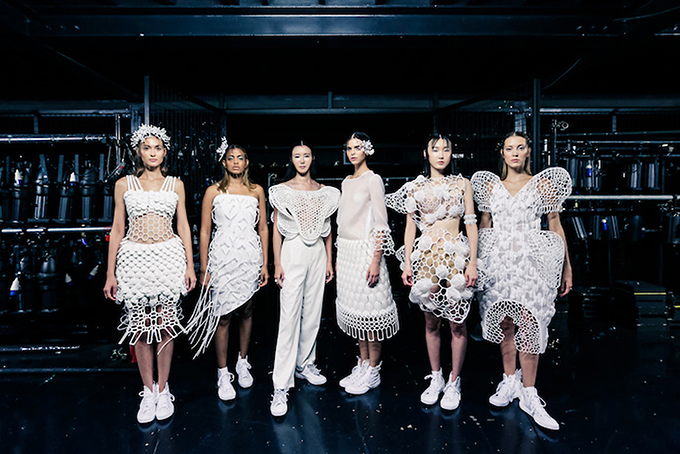When Jamela Law, one half of the design duo behind local brand Baëlf Design, was still a student at LASALLE College of the Arts, there was no course offered in 3D modelling. In fact, her proposal of a 3D printed collection was met with much skepticism by her programme leader as there were few other students interested in exploring this field at the time.
Since Law graduated in 2017, much has changed. The very next year, LASALLE officially introduced mandatory 3D modelling classes into the Fashion Design and Textiles programme and, as fate would have it, has now commissioned Baëlf Design to develop 3D printed fabric swatch samples for their students.

And yet, in other ways, the 3D printed fashion landscape in Singapore has remained rather stagnant. Besides Law, Baëlf believes no other local designer has done another 3D printed dress collection. Law tells Vogue: “In a way, we are the guinea pigs, conducting this grand 3D printing fashion experiment with the entire industry keeping an eye on us to see how we end up.”
The current state of 3D printing in Singapore
In Singapore, 3D printing is still largely contained to footwear, accessories and jewellery. If the technology is being integrated into garments, it is more often haute couture pieces rather than ready-to-wear. That 3D printing has not yet entered the mass consumer market is partly a deliberate decision made by the designers. For local brands dabbling in 3D technology, such as Baëlf and Grace Ling—who uses it to complement her garment designs—many of them choose to keep their offerings selective instead of following the conventional retail mindset of trying to reach as many consumers as possible.

Ling says of her eponymous brand, “I think it takes a certain kind of style to be drawn to my brand. I plan to keep my [future] designs authentic to the original brand DNA, and whoever is drawn to it will be drawn to it.” Lionel Wong, the other half of Baëlf Design, expresses a similar sentiment: “We do not have interest in mass-producing our designs [since] the world already has enough stuff. We seek to question the status quo in the context of an extremely capitalistic, materialistic world obsessed with consumption.”
Baëlf’s emphasis on conscientious consumerism goes back to the tenet of sustainability that has helped shape both their and Ling’s decision to integrate 3D technology into their creative process. With 3D design and printing, designers are able to customise their creations to suit every individual customer’s precise physical profile and preferences. Since they know the exact amount of material needed to create each item, the amount of waste produced during the sampling and manufacturing stages is significantly reduced. The ability offered by 3D printing technology to manufacture on demand also reduces the need to stock extra inventory.

Yet, despite the myriad benefits offered by 3D printing technology, most homegrown brands still rely exclusively on traditional manual craftsmanship. Wong recounts, “A local seasoned jewellery designer once told Jamela and me that she will not use the 3D printing, made-to-order model for her business because she does not want to eat chicken rice for the rest of her life.” A quirky soundbite, but one that speaks to the lack of confidence by Singapore fashion designers in the business feasibility of leveraging 3D technology.

Hurdles to integrating 3D printing
Although 3D printing equipment has become more accessible and less expensive in recent years, the cost remains significant. Furthermore, a large amount of space is needed to host the bulky 3D printers, and given Singapore’s land scarcity and corresponding high rental rates, it’s a deterrent to local designers investing into the technology. While there are local 3D printing service providers, Law points out that most focus on industrial materials and do not offer post-processing services like gold plating, which is crucial for jewellery design.
Limitations in extant 3D printing materials and techniques also curtail the efficacy of this technology in garment creation. Until the materials used can attain a level of comfort and malleability comparable to that of traditional fibers, it remains a hurdle for 3D printing to enter the realm of wearable everyday garments.

More institutional funding for research in this field will help, but Law has her reservations. “The design industry has not really been the focus of additive manufacturing resources and research as much as other industries such as biochemistry and engineering in Singapore. The results produced by those industries can be monetised, patented and exported overseas, in contrast to applications in the art and design field which are devoted to smaller audiences with less potential for development.”
Law also shares that most funding for fashion projects is centred on eye-catching visual outcomes: “Not too many sponsors will fund projects that are experiments. They do not care too much about the process, which means that most of the time, the initial investment for a project has to be incurred by us, the designers.”

Other than cost, Baëlf cites the lack of cross-industry collaborations as a reason why 3D fashion has not taken off in Singapore the way it has in the West. According to Wong and Law, collaborations between designers and technologists do take place in Singapore, but are usually one-off affairs, due to the dominant culture in Singapore that prizes engineering vocations while treating art and design as frivolous pursuits. As a point of contrast, consider Dutch designer Iris van Herpern who brings in a technologist almost every season to render her creative vision for her garments.
Hints of a 3D technology sea change
Moves are being made in Singapore to promote the use of 3D technology within the fashion industry. The National Additive Manufacturing–Innovation Cluster (NAMIC) seeks to forge more collaborations between additive manufacturing researchers and companies that they believe can benefit from 3D technology. They have helped instigate several ongoing partnerships in this realm, such as one between researchers at the Nanyang Technological University and designers at RESA to 3D print customised shoe insoles.

NAMIC also works to popularise 3D technology among local designers through running conferences and summits, inviting arts schools such as LASALLE and Nanyang Academy of Fine Arts to trade events, and offering capability development support and courses to institutions such as the Textile and Fashion Federation. “Once designers see that 3D printing can be applied to products beyond just accessories and they get the hang of it, I’m sure we will see very interesting designs and greater integration of 3D technology into wearable fashion,” says Mahendran Reddy, Director of Ecosystem Development at NAMIC.
If everyone adopts a one-answer-for-everything approach, there will be no space for creativity in such a reductive environment.
However, Baëlf’s Wong and Law believe a systemic shift in Singaporeans’ collective philosophy is needed for 3D printed fashion to truly take off—one that requires buy-in from all major stakeholders. Namely, not only should the government provide more funding for creative work and platforms for exchanges with overseas institutions, even those with controversial ideas, design schools can also help by hosting exhibitions from non-mainstream designers and bringing back alumni to introduce alternative design approaches to current students. They also believe local designers should more actively support one another: “We often hear other designers commenting on whether our designs will sell, as if market popularity is the singular metric for judging a designer. We argue there should always be space in any industry for alternative views, because if everyone adopts a one-answer-for-everything approach, there will not be space for creativity in such a reductive environment.”

The role of the consumer
However, designers form only one side of the equation; consumers are the crucial other half that determine if there is greater room for 3D printed fashion in the local market. On one hand, Ling doesn’t believe that the 3D printed nature of an item plays a role in attracting consumer interest: “I don’t think people necessarily think ‘Oh, I am going to buy a 3D printed bag’. They are drawn to the design, aesthetic and brand vision, and then are pleasantly surprised to later find out it’s 3D printed.”
However, NAMIC’s Reddy holds a different view: “I think Singaporeans are always looking for new and trendy items, so knowing that an item was 3D printed will grab their interest.” Wong and Law share the same perspective, saying, “To pique consumers’ interest, we need to design something that is truly, only feasible with 3D printing. Minimalist designs that can be rendered via traditional processes are not as effective, as the audience will not see the merit nor the excitement of the 3D printing process. What interests them is not the technology, but the narrative that goes into the project.”

Because of the prohibitively high production costs, every 3D printed item is priced higher than their manually-produced counterparts—another reason why 3D printed fashion has yet to make a splash in the mainstream market. But Reddy is confident that a burgeoning interest in sustainability will help offset price considerations. “It’s like with reusable straws—disposable ones are so cheap but once people realized the negative environmental impacts of using them, they are willing to pay more for a reusable straw,” he says. “The younger generation is more aware of the climate crisis, so if they know that 3D printing can help reduce waste and carbon footprint, they will be willing to pay a higher price for 3D printed items.”
To this end, there is increasing focus on maximising the sustainability of 3D printing materials in order to really leverage the environmental benefits offered by this technology over manual craftmanship. Current 3D printing technologies tend to rely on synthetic materials, so the waste reduction achieved may be cancelled out by the extraction of fossil fuels to create those plastics. Baëlf does use fully biodegradable—and pricier—alternatives such as NonOilen 3D printing filament. However, Wong and Law are optimistic that when more designers and corporations are educated in the benefits of sustainable design, there will be higher adoption rates which will help to bring costs down. Chu Wong, country coordinator of Fashion Revolution Singapore, suggests Wholegarment 3D Knitting as a happy medium that resembles 3D printing but uses natural fibers; this technology has already been used by major brands like Uniqlo, which released a 3D knit collection for women.

The future of 3D technology in Singapore
Major strides have been made at the nexus of 3D technology and fashion in Singapore over the past few years. However, the road to integrating 3D printed fashion into the mass commercial market is still a long one. 3D manufacturing need not take place at the expense of traditional methods; in fact, Ling believes 3D printing technology will only elevate the speed, design, and environmental-friendliness of manual crafting. The future of 3D printed fashion in Singapore looks set to be an exciting one.

And leading the pack will be young designers, who Reddy believes will adapt to this new fashion form quickly. After all, they grew up online and are used to communicating through visuals, and 3D technology is fundamentally a very visual medium.
The younger generation of creatives like Ling, Wong and Law are not shying away from the challenge. They are already looking to expand their repertoire and further their skills. Wong sums it perfectly with this emphatic declaration: “We cannot be shy about experimenting, and we should fail and fail spectacularly in order for innovation to happen.”





